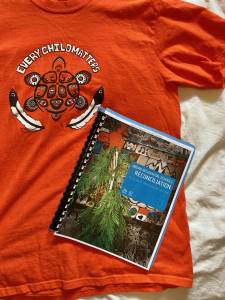12 Indian Residential Schools and Reconciliation Teacher Resource Guide
Jordan Kidd
Contributor’s Biography:
Jordan Kidd is a fourth-year student at Kwantlen Polytechnic University who will be receiving a Bachelor of Arts with a minor in Counselling. Jordan is on the road to becoming an elementary school teacher and aspires to teach children significant Indigenous Knowledges.
Resource Overview
Weblink-PDF Document
First Nations Education Steering Committee and First Nations Schools Association. (2015). Grade 5 Indian Residential Schools and reconciliation. http://www.fnesc.ca/wp/wp-content/uploads/2020/07/PUBLICATION-IRSR-5-rev-2b-Full-Document-2020-07.pdf
Grade Level: Grade five
Description:
The resource was created by the Truth and Reconciliation Commission of Canada to aid in educating children about Residential Schools. This particular resource aims to help strengthen relationships between Indigenous and non-Indigenous Peoples by providing participants with historical context. The resource is from The Royal Commission on Aboriginal Peoples, which talks about four principles, a renewed mutual recognition, respect, sharing, and responsibility (First Nations Education Steering Committee [FNESC], 2015, p. 3). The resource demonstrates how to navigate this topic sensitively by providing books, vocabulary, questions, and other resources. It also supplies information to help participants connect with someone if they have struggles regarding the topic, such as the Indian Residential Schools Crisis Lines and Kids Help Phone.
Significant Indigenous Knowledge:
One of the pedagogies that this resource uses is the First Peoples pedagogy which shows participants different ways of learning through Indigenous worldviews. The curriculum focuses on the learner being at the centre and engages participants through experiential learning. It also allows participants to be aware of self and others and demonstrates the value of the group process, and supports all learning styles while teaching through an Indigenous perspective (FNESC, 2015, p. 6). The resource’s pedagogy is based on the First Peoples’ Principles of Learning which centres on learning that supports self, family, community, land, spirits, and ancestors (FNESC, 2015, p. 7).
Necessary Prior Knowledge:
Before using this resource, it is recommended that the educator becomes familiar with the history of colonization and its effects on Indigenous communities. To enhance the understanding and the effects of historical colonialism, it is essential that the educator review either a summary of the final report or the entirety of documents within the Truth and Reconciliation Commissions of Canada. The resource effectively dissects concepts for the educator. For example, it defines reconciliation and Residential schools to make the content easier to understand. It also provides links to different websites to help educators gain proficient knowledge on these themes. Since the topic is emotional, it is recommended that the educator be prepared to approach the subject with sensitivity. The resource is best taught when encouraging classroom discussions by asking questions and encouraging engagement from the participants (FNESC, 2015, p. 7). As this topic may be challenging for families with Residential School Survivors it is highly recommended that the educator shares a notice with parents beforehand, giving students the choice to opt out.
Suggested Learning Activities
The resource provides an activity titled “Remembering the Land” intended for the English Language Arts for grade five participants. The lesson is paired with a book called “Shi-shi-etko.” The book is about a young Indigenous girl who spends her last few days with her family before leaving for school. They teach her the importance of the land, and she collects plants to put in a memory bag to help her remember the lessons. The book does not explicitly mention Residential Schools but implies that this is where she is going. An essential theme of the book is remembering because we must not forget the effects of Residential Schools. There is also a video option available for purchase online, or there is a 6-minute clip of it on YouTube. The educator would ask the class to listen to what the family members teach her before reading the book. Next, the educator would focus on sensory imagery, which invokes one of the five senses by asking participants to reflect on such images in the book. After, a lesson on the literary device would ensue. The educator can lead a discussion on how sensory images help us better understand. Educators can also pair a writing activity with the lesson to help participants better understand imagery when writing. The educator could get participants to write a short story with examples of sensory images (FNESC, 2015, p. 13).
Another possible activity is that the educator can discuss the memory bag from the story and ask participants why Shi-shi-etko was putting different plants in her memory bag. Then, they can shift the conversation to focus on which plants grow in their neighbourhood. They could go outside for a walk to look at the different plants growing and take pictures to document them. Participants should be discouraged from taking plants during the walk unless they have been taught to respectfully take from the land. Alternatively, the educator could use this opportunity to teach participants how to respectfully take from the land. Robin Wall Kimmerer discusses the teachings of plants in “Braiding Sweetgrass.” She explains that to respect the plant one must be thankful and leave a gift such as tobacco. The picker must also ask the plant if it can be picked and be delicate when cultivating. To be respectful one must be “careful not to disturb the roots” and “take only what we need” (Kimmerer, 2013, p.157). The activity can also tie in with the sensory imagery writing activity because they could be asked to note what senses were engaged during their walk (FNESC, 2015, p. 13).

Indian Residential Schools & Reconciliation
Image by: Rachel Chong BY-NC-ND (Attribution Non-Commercial No Derivatives)
References
First Nations Education Steering Committee and First Nations Schools Association. (2015). Grade 5 Indian Residential Schools and reconciliation. http://www.fnesc.ca/wp/wp-content/uploads/2020/07/PUBLICATION-IRSR-5-rev-2b-Full-Document-2020-07.pdf
Truth and Reconciliation Commission of Canada. (2015). Honouring the truth, reconciling for the future: Summary of the final report of the truth and reconciliation commission of Canada. https://web.archive.org/web/20200430162813/http://www.trc.ca/assets/pdf/Honouring_the_Truth_Reconciling_for_the_Future_July_23_2015.pdf
Kimmerer, R. (2013). Braiding sweetgrass. Milkweed Editions.

